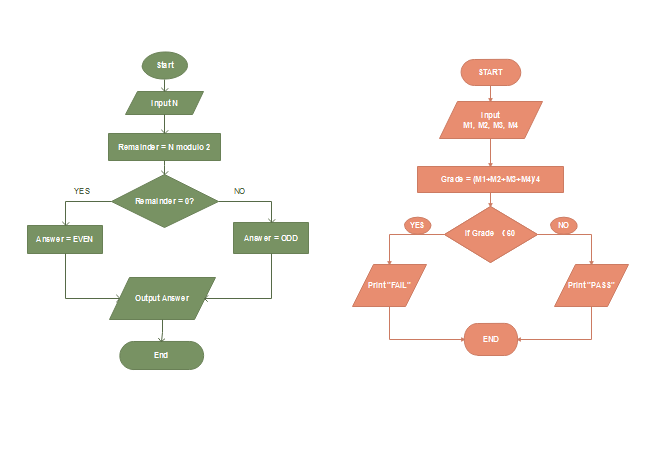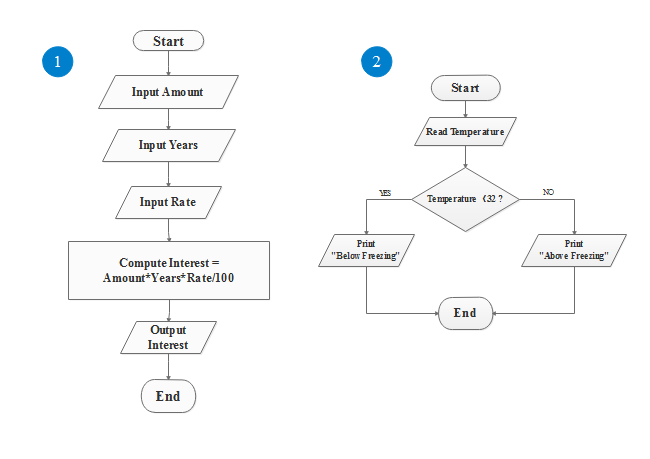
An algorithm chart is a visual representation of the steps and decisions involved in solving a problem or completing a task using an algorithm. It provides a clear and organized way to understand how an algorithm works, making it easier for programmers and developers to design, implement, and troubleshoot algorithms.
Algorithm charts are typically created using flowchart symbols and arrows to represent the flow of logic and decision-making. Each symbol represents a specific action or operation, such as input/output, calculations, conditionals, loops, and more. By following the flow of the chart, one can trace the path of the algorithm and understand how it processes data and produces results.
How to Create an Algorithm Chart?
Creating an algorithm chart involves several steps, starting with understanding the problem or task at hand. Here’s a step-by-step guide on how to create an algorithm chart:
- Identify the problem: Clearly define the problem or task you want to solve using an algorithm. This step is crucial as it lays the foundation for the entire chart.
- Break it down: Break down the problem into smaller, manageable steps. This helps simplify the algorithm and makes it easier to design and implement.
- Define inputs and outputs: Determine the inputs and outputs required for the algorithm. Inputs are the data or variables needed to perform the calculations or operations, while outputs are the results or outcomes.
- Create symbols: Choose the appropriate symbols to represent each step or action in the algorithm. Common symbols include rectangles for processes, diamonds for decisions, and arrows for flow control.
- Connect the symbols: Use arrows to connect the symbols and show the flow of logic and decision-making. This ensures that the algorithm follows a specific sequence and produces the desired results.
- Test and refine: Test the algorithm chart with sample data to ensure it functions as expected. If any issues or errors arise, refine the chart by making necessary adjustments.
Why Use an Algorithm Chart?
Algorithm charts offer several benefits and advantages, making them an essential tool for programmers and developers. Here are some reasons why you should consider using an algorithm chart:
- Visual representation: Algorithm charts provide a visual representation of the algorithm, making it easier to understand and follow the logic.
- Structured approach: By breaking down the problem into smaller steps, algorithm charts provide a structured approach to problem-solving.
- Efficient troubleshooting: When encountering issues or errors, algorithm charts make it easier to identify and fix the problem by tracing the flow of logic.
- Collaboration: Algorithm charts can be shared and discussed among team members, facilitating collaboration and ensuring everyone is on the same page.
- Documentation: Algorithm charts serve as documentation for future reference. They provide a clear record of the algorithm’s design and implementation.
Examples of Algorithm Charts




To further illustrate the concept of algorithm charts, here are a few examples:
1. Sorting Algorithm
A sorting algorithm chart may include symbols such as rectangles for comparing elements, diamonds for conditionals, and arrows for swapping elements. The chart would illustrate the step-by-step process of sorting a list of numbers.
2. Binary Search Algorithm
A binary search algorithm chart may include symbols like rectangles for comparing elements, diamonds for conditionals, and arrows for dividing the search space in half. The chart would show how the algorithm searches for a specific element in a sorted list.
3. Fibonacci Sequence Algorithm
An algorithm chart for generating the Fibonacci sequence may include symbols like rectangles for calculations, diamonds for conditionals, and arrows for updating variables. The chart would demonstrate how the sequence is generated based on the previous two numbers.
4. Graph Traversal Algorithm
A graph traversal algorithm chart may include symbols like rectangles for visiting nodes, diamonds for conditionals, and arrows for traversing edges. The chart would outline the steps involved in exploring a graph data structure.
5. Linear Regression Algorithm
An algorithm chart for linear regression may include symbols like rectangles for calculations, diamonds for conditionals, and arrows for updating coefficients. The chart would depict the process of fitting a line to a set of data points.
6. String Matching Algorithm
A string-matching algorithm chart may include symbols like rectangles for comparing characters, diamonds for conditionals, and arrows for moving through the string. The chart would illustrate how the algorithm searches for a specific pattern within a larger string.
7. Depth-First Search Algorithm
An algorithm chart for depth-first search may include symbols like rectangles for visiting nodes, diamonds for conditionals, and arrows for traversing edges. The chart would demonstrate the process of exploring a graph by going as deep as possible before backtracking.
8. Dijkstra’s Algorithm
A chart for Dijkstra’s algorithm may include symbols like rectangles for calculations, diamonds for conditionals, and arrows for updating distances. The chart would outline the steps involved in finding the shortest path between two nodes in a weighted graph.
Conclusion
An algorithm chart is a valuable tool for understanding, designing, and implementing algorithms. It provides a visual representation of the steps and decisions involved in solving a problem or completing a task. By following the flow of the chart, programmers and developers can trace the path of the algorithm and ensure it functions as intended. Whether you’re a beginner or an experienced programmer, algorithm charts can greatly enhance your problem-solving skills and make complex algorithms more manageable.
Algorithm Chart Template – Download